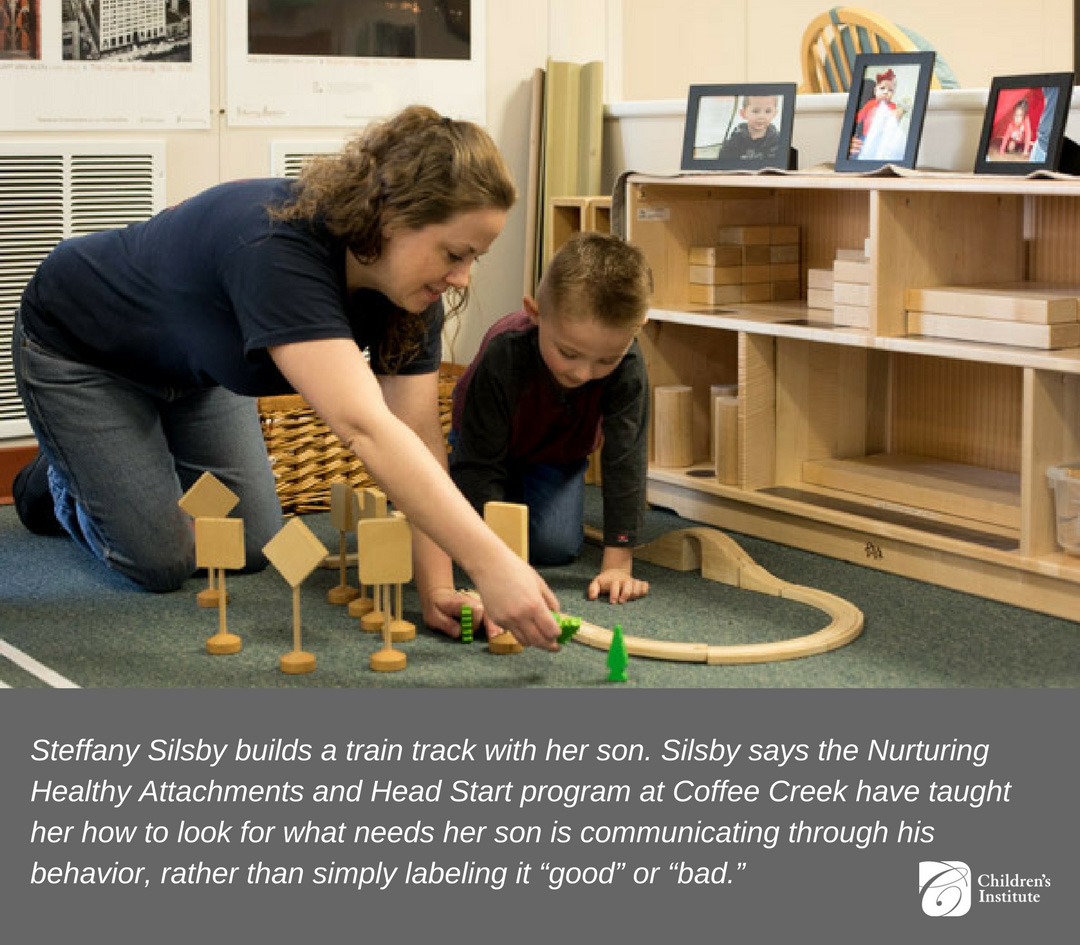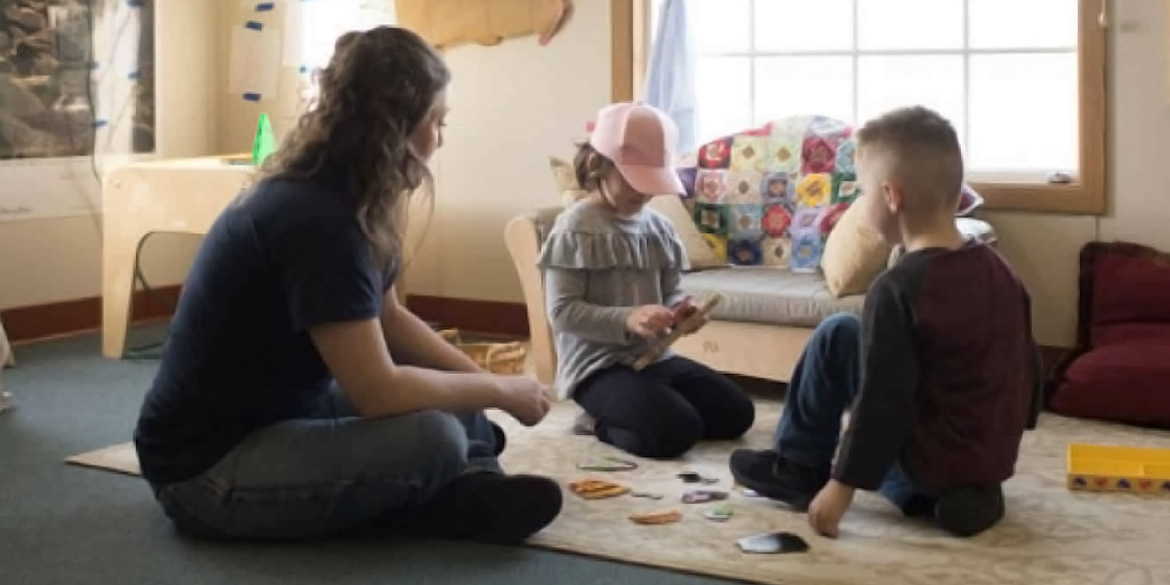Trauma, chaos and unrelenting stress can overwhelm anyone’s ability to nurture. For incarcerated parents, these hardships often have been a way of life. Being in prison only adds another layer of complexity to their relationship with their children.
Between 1980 and 2016, the number of women incarcerated in the United States increased by more than 700 percent, rising from a total of 26,378 in 1980 to 213,722 in 2016. More than 60 percent of women in state prisons have children under age 18, according to The Sentencing Project, and the U.S. Bureau of Justice Statistics reports that roughly half of incarcerated mothers were single parents at the time of their arrest. The statistics add up to more children than ever suffering negative consequences of having a mother behind bars, children who themselves become at risk of school problems, economic hardship and criminal activity, according to the National Institute of Justice.

But statistics are not an absolute predictor of future catastrophe. Research shows that a strong parent-child bond and well-functioning social support system play significant roles in the child’s ability to surmount these challenges and thrive.
Mindful of these facts, developmental behavioral pediatrician Sherri Alderman, president of the Oregon Infant Mental Health Association, has designed a program that can not only strengthen the parent-child bond, but provides a research-based way for parents to reset their approach to interacting with their children.
In 2017, she created a pilot project called Nurturing Healthy Attachments for the Coffee Creek Correctional Facility, Oregon’s only prison for women (it also houses a smaller population of men). The program’s three-pronged approach combined components Alderman knew from her research and experience over decades of working with vulnerable families could interrupt negative, hand-me-down parenting patterns and knit families closer together:
- Circle of Security,
- Vroom and
- the CDC’s Act Early program.
Together, they help mothers understand their child’s behavior and their own reactions, then provide a structure to practice new ways of interacting.
Coffee Creek already had a Head Start program for incarcerated mothers with children aged birth to five who attend two half days a week with their children in the classroom. Alderman designed Nurturing Healthy Attachments to dovetail with and enhance the excellent program already in place.
Triad of Support
Circle of Security is a Spokane, Washington-based organization that provides training and workshops worldwide using the science of attachment research to create a guided process of self-discovery into how a parent’s personal history affects the way they relate to their child. For the two and a half months of the Nurturing Healthy Attachments program, the mothers attended a weekly, two-hour Circle of Security session, in addition to their Head Start program. They delved into their life experiences to develop insights that helped them transform their automatic reactions into behaviors more aligned with the child’s needs.
“Having a struggling parent is difficult enough for a child,” says Deidre Quinlan, Circle of Security’s Project and Professional Development director. “Abuse, neglect, mental illness, homelessness and addiction all stress the developing child. Then the [judicial/correctional] system removes the parent from the child, which adds another layer of trauma to the developing person.”
Through working with the adults in a child’s life, Circle of Security works to ensure children have strong, kind, committed adults who are there for them, who provide a secure base when the child is out exploring and a safe haven when they return.
“Without this knowledge, the child cannot learn well. This ‘felt safety’ comes from repeated events, thousands of times in the earliest days of the life of the baby and sets the template for how the child will come to understand what it means to be a person in relationship as they move forward in life.”
Vroom, the second component in the project, is a free science-based program and with downloadable resources, including a mobile app and SMS-text platform, that turns the latest research on early learning brain development into playful, actionable tips and activities parents can enjoy with their children ages 0-5. Activities turn routine shared moments—mealtimes, bathing, taking a bus—into brain-building moments. Each tip also provides the “Brainy Background” of how that activity helps develop the child’s brain.
“This is where Vroom really picks up,” Alderman says. “Vroom provides concrete suggestions of activities, so that the women can come back and say, ‘I tried Vroom, and this is how it went,’ when they go to their next Circle of Security session.”
Nurturing Healthy Attachments’ third component incorporates the Centers for Disease Control and Prevention’s Learn the Signs. Act Early program. After a baby’s birth, mothers don’t automatically know what happens next and their inexperience in understanding their child’s development can have dire consequences. Unrealistic expectations of a child’s behavior relative to their developmental age is a major risk factor for child abuse, Alderman says.
The Act Early program provides parents and caregivers science-based information on what behavior to expect from a child from age 2 months to 5 years, so a parent can see, for example, that a wailing toddler is not “being a brat,” but needs something and doesn’t have the language to communicate it.
Listening for Sharks

The work of Circle of Security, Quinlan says, is to bring the unconscious to the level where it can be perceived. “When stressed, the amygdala triggers a fight-or-flight response, and in the Circle of Security, we call that ‘Shark Music.’ We use that metaphor as a way to recognize the non-verbal signals in the body and bring our thinking brain (the prefrontal cortex) online by naming it. As (psychologist and best-selling author) Dan Siegel says, ‘You have to name it to tame it.’”
The three components that comprise Nurturing Healthy Attachments each approach a fundamental issue at the heart of attachment: fear. Fear from the mother’s upbringing, fear of not knowing what she is doing, fear of getting it wrong, fear of being disrespected, even fear of her own child. In learning to recognize the shark when it rears its unhelpful head, the women learn to be in the present and to respond to their child in real time.
Vrooming Old School
Because the incarcerated moms are not allowed to use smartphones, Alderman “reverse engineered” the Vroom app and printed out hard copies of the activities with their explanations of brain-building moments.
The adaptation worked great, says Coffee Creek’s Head Start teacher Carmen Slothower. Alderman posted 8 ½ x 11-inch copies of the tip printouts throughout the classroom. Then she created Vroom “tickets” to give the moms, 4 x 6-inch slips of paper that had the name, description of the activity and the brain-building moment on them.
“The mother could pick what she wanted to do,” Slothower says, “and on the back of the tickets there was space for her to write her anecdotes of engaging in the activity together with her child and her reactions and feelings about that.
“The mothers also could send the tickets home with the child’s caregiver, sharing that they had ‘Vroomed’ with their child in class. It was a wonderful way for mothers to share a positive experience of what they did with their child that day.”
The tickets also provided a bit of themselves that the mother could give to the caregiver, which could spark a conversation with the child about the activity and how the morning went. This interaction reinforced the activity and helped smooth the child’s transition between mother and caregiver.
Next Steps

The pilot project’s success has inspired Alderman to move forward in looking for ways to replicate it in other arenas. “We know that the model works, and I would love to see it disseminated widely so that as many people as possible can benefit from it,” she says. “There are some facilities where the child actually stays with the mom while she is in residential treatment for substance abuse and the program would work well there.”
She is continuing to work with Oregon’s Women’s Services agency on the state level, where Nurturing Healthy Attachments was well-received, to explore possibilities for expanding the program’s reach. A recent development is that Department of Corrections staff has expressed interest in implementing the adapted Vroom activities in the Coffee Creek facility itself to provide access for mothers during child visits, Alderman says.
Meanwhile, Community Action Organization of Washington County, Coffee Creek’s parent organization, has sent one of its supervisors to the Circle of Security training and is sending two more supervisors, as well as its 15 home-based program’s home visitors this month.
For more information on the Nurturing Healthy Attachments program, please contact Dr. Sherri Alderman, sherri.alderman23@gmail.com. Circle of Security offers animated videos in English and Spanish that can be downloaded and shared: www.circleofsecurityinternational.com. The CDC’s free milestone tracker app for “Learn the Signs. Act Early” can be downloaded at www.CDC.gov/ncbddd/actearly.

K.C. Compton
K.C. Compton worked as a reporter, editor and columnist for newspapers throughout the Rocky Mountain region for 20 years before moving to the Kansas City area as an editor for Mother Earth News. She has been in Seattle since 2016, enjoying life as a freelance and contract writer and editor.



